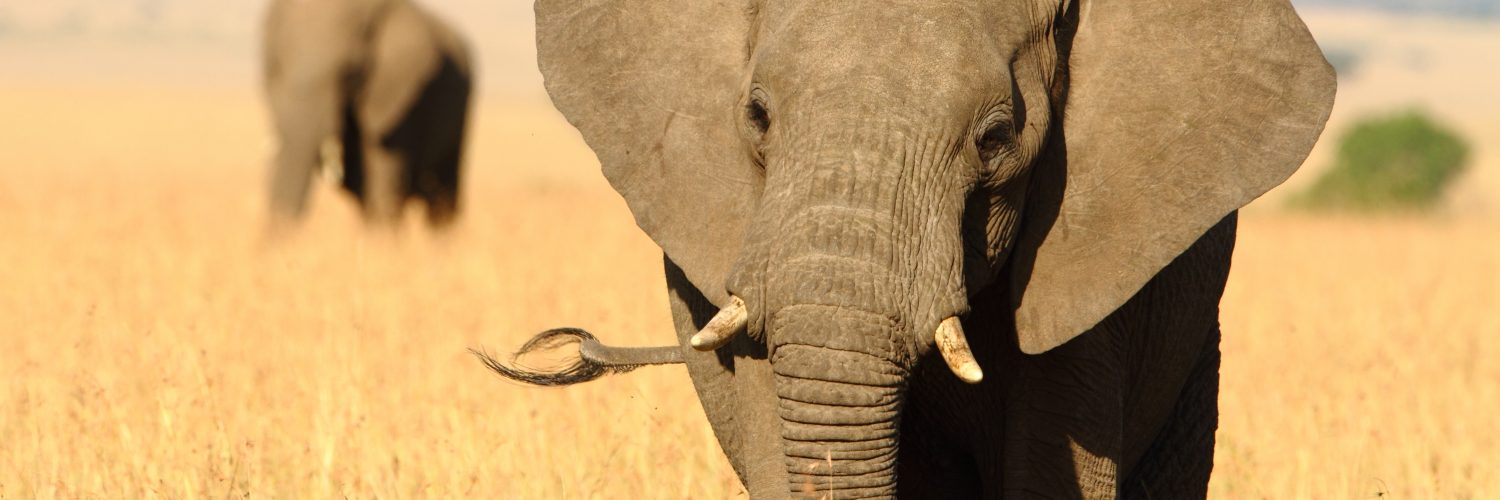Introduction to the African and Asian elephants
Elephants are large herbivorous mammals which belong to the order Proboscidea. The name “Proboscidea” was first used by Illiger in 1811 for recent elephants because the long flexible proboscis or trunk, a combination of nose and upper lip, is the most distinguishing feature of these mammals. However earliest proboscideans did not have a trunk, but perhaps a mobile upper lip. Proboscideans are classified into the Tethytheria, together with their extant sister-group Sirenia and with the extinct order Desmostylia.
Elephants have evolve from a pig size ancestor that lived in northern Africa about 50-60 million years ago. Through time, order Proboscidea comprised of more than 350 species. But today order proboscidea is represented by only three living elephant species. Elephants are belong to two extant genera Loxodonta (African genus) and Elephas (Asian genus) in family Elephantidae. The extant three species of elephants are,
- Loxodonta africana (African savanna elephants)
- Loxodonta cyclotis (African forest elephants)
- Elephas maximus (Asian elephants)

Fig.01.1. Comparison of the body sizes of adult Elephas maximus (Asian elephants), Loxodonta africana (African savanna elephants) and Loxodonta cyclotis (African forest elephants). [https://elephantaidinternational.org/elephant-facts/]
Scientists believe that the origin of the ancestors of both loxodonta and Elephas took place in African forests. Shift towards drier climes in Africa drove the development of these new species. It is suggested that a drier climate caused habitat fragmentation, such as the break-up of forest areas, isolating groups of animals and thereby leading to species divergence.
Approximately 7.5 million years ago in the Neogene period, the ancestors of the African elephants and Asian elephants on this planet were separated and thus began to evolve separately in the African and Asian continents. Recent genetic studies on genome sequence of African elephants, Asian elephants and Wooly mammoths, reveals that the Asian elephants are more close to Wooly mammoth than the African elephants. Wooly mammoth have shared a common ancestor with Asian elephants about 5.8-7.7 million years ago, roughly around the Humans and Chimpanzees last shared a common ancestor (Fig.01.1). The evolutionary relationships of wooly mammoth to the Asian elephants and African elephants will be discussed later.

Fig.01.1. Phylogeny and divergence times of four proboscidean species, based on mitochondrial genome sequence analysis. PLoS Biology (DOI: 10.1371/journal.pbio.0050207)
Due to the climatic differences in these two habitats, African elephants which live in savanna like hot climates are contrast from Asian elephants which live in relatively wet climate. Asian genera can easily distinguish from African genera based on their external morphological features (see table 01.1). Chromosome complement, however, is 2N=56 in both the genera
Differences between African elephants and Asian elephants
Size and the weigh
African savanna elephants are comparatively larger than the Asian elephants. However African forest elephants are the smallest out of all three species. African elephants’ shoulder height is less than the head while the shoulder height is higher than the head in Asian elephants. Adult African elephants are average weight about, 4,000-7,500 kg while adult Asian elephants are weight about 3,000-6,000 kg.

Fig.01.3. External morphology of elephants; Genus Elephas (Asian genus), Genus Loxodonta (African genus). [https://1.bp.blogspot.com/-kHHtDp584Vk/Te-UfAB8fZI/AAAAAAAADy8/Il0coAe5S6E/s1600/elephant.+2.bmp]
Head
African elephants’ head is more rounded, no hums in forehead and smaller compared to the body size whereas Asian elephants’ forehead has two humps and head is larger compared with the body size.
Trunk
The trunk is a completely muscular long nose which is use to drag foods on the ground as well as leaves and fruits from tall trees. They drink water by sucking in to the mouth up to four liters at a time and squirting it in to the mouth. Both African and the Asian elephants use their trunk to spray water, mud or dust on to the body in order to keep their body cooler under hot climate. Also elephant have an excellent sense of smell, and the trunk may be held up right in the air like a periscope to gain olfactory information from the surrounding. The trunk of an African elephant is heavily ringed and softer than the trunk of Asian elephants. The tip of the trunk has finger like projections known as lips which is use to pick up and manipulate small objects. The tip of the trunk of African elephants have two lips whereas Asian elephants have a single lip.
Mouth and the teeth
Asian elephants have long tapered lover lips while African elephants have comparatively short and round lover lips. The dental formula of elephants is 1/0, 0/0, 3/3, 3/3 =26, and the teeth are highly specialized. The remaining upper incisor in extant elephants is the second (I2) and forms the characteristic tusk. Tusks are composed of dentine and calcium salts, with enamel only the terminal portion. Those are open rooted and grows throughout the life. In female Asian elephants tusk are smaller and may not extent beyond the lower lip. But the African elephants have comparatively larger tusks and both the male and female elephants have tusks. The cheek teeth are large and hypsodont, with transverse laminae (ridges). These ridges are composed of dentine overlaid with enamel. Cement occurs between the ridges. Posterior cheek teeth are larger than those anterior and have a greater number of ridges. Only one upper and one lover molar are active in each jaw at a time. They have six teeth sets throughout the lifespan while the replacement of cheek teeth is horizontal. The final set of teeth begin to come in about 30 years of age. African elephants have comparatively less laminae on occlusal surface on the cheek teeth and Contains oval shaped plates. Asian elephants have laminae on the occlusal surface on the cheek teeth comparatively more than the African elephants (as mandible short and cheek teeth long in Asian elephant) and Contains diamond shaped plates. As the diet of Asian elephant is based on more grasses than the leaves compared to the African elephants, having more lamine on occlusal surface is an adaptation for their mode of life.
However the chromosome complement, is 2N=56 in both the Asian and African elephants.
| Feature | African genus (Loxodonta) | Asian genus (Elephas) |
| Height (according to the highest position of the body) | 3.5m (comparatively taller) Shoulder height less than the head | 3m Shoulder height than the head |
| Average weight of an adult | 4,000-7,500 kg | 3,000-6,000 kg |
| Shape of the back | Concave back | Convex back |
| Fore head | No humps | Has two humps |
| Size of the head | Smaller compared to the body size | Larger compared to the body size |
| Tip of the trunk | Two finger like projections or lips | One finger like projection or lip |
| Ears | Large with no folds | Relatively smaller with folds |
| Tusks | Large tusks Both the males and females have | Relatively smaller tusks Only males have (No tusks in female Asian elephants) |
| Teeth | Comparatively less laminae on occlusal surface on the cheek teeth. Contains oval shaped plates | Have laminae on the occlusal surface on the cheek teeth comparatively more than the African elephants (as mandible short and cheek teeth long in Asian elephant). Contains diamond shaped plates |
| Ribs | 20 pairs of ribs | 19 pairs of ribs |
| Number of toe nails | Fore feet (4) Hind feet (3) | Fore feet (5) Hind feet (4) |
| De-pigmentation | Absent | Present |
Table 01.1. Comparison of externally visible morphological differences between African elephants and Asian elephants

Map 01.1. The current distribution of elephants throughout the world. Green colour – African elephants, Red colour – Asian elephants [https://media.londolozi.com/wp-content/uploads/2016/09/11010653/Elephant-distribution.png
Asian elephants are representing 10% out of total global elephant population, but the genetic diversity is higher than the African population. Even in a single population of Asian elephants each of the individual are identical to each other by some of the external features such as ear folds and de-pigmentation pattern. Asian elephants are further divided in to three sub species based on genetic data;
- Elephas maximus maximus (from Sri Lanka)
- Elephas maximus sumatrensis (from Sumatra)
- E.maximus indicus (from Indian subcontinent).
However morphologically these three sub species are much similar to each other, only show few differences such as skin colour and de-pigmentation.
The Asian elephant is the largest land animal inhabiting the Asian continent. Historically, the range of the Asian elephant had been extended from the Euphrates and Tigris Rivers in west Asia to the Yangtze-Kiang River in China. Exponential growth of human populations and forest cover changes over the past few decades have extirpated Asian elephants from approximately 85% of their former range. As a ‘free ranging’ or ‘wild’ species, the Asian elephant is now limited to a number of isolated and fragmented populations in 13 south and southeast Asian countries with a total estimated population of 35,000-50,000. Now the Asian elephant (Elephas maximus) is considered an ‘endangered species’ due to the declining population.

Map 01.2. Map of the current and the former distribution of Asian elephants [https://www.intrepidtravel.com/sites/intrepid/files/basic_page/files/Elephant_Distribution_Map.jpg
The adult elephants are completely herbivorous. The average life span of an Asian elephants is approximately 60 years with the oldest on record being 80 years. They have the longest gestation period of all animals with conception to birth taking 22 months. Elephants by nature social animals with females and young living in herds. Typically the herd is leads by a matriarch. Juvenile males leave herds when they become sexually mature, between 10 and 17 years. Adult males may be either solitary or in temporary all male groups, with overlapping home range, but change on the time of the year. Diversity among the Asian elephant population will be discussed in a later part.
Author
Sanaka Wickramasooriya
Undergraduate
BSc. (Hons. in Zoology)
University of Colombo
Faculty of Science
References: Fernando, P. (2000). Elephants in Sri Lanka: past, present, and future. Loris, 22(2), 38–44. Kurtén, B. (2018). Order Proboscidea. Pleistocene Mammals of Europe, https://doi.org/10.4324/9781315126470-13 Fig.01.1. Comparison of the body sizes of adult Elephas maximus (Asian elephants), Loxodonta africana (African savanna elephants) and Loxodonta cyclotis (African forest elephants). Available at: https://elephantaidinternational.org/elephant-facts/ Fig.01.2. Phylogeny and divergence times of four proboscidean species, based on mitochondrial genome sequence analysis. Available at: PLoS Biology (DOI: 10.1371/journal.pbio.0050207) Fig.01.3. External morphology of elephants; Genus Elephas (Asian genus), Genus Loxodonta (African genus). Available at: https://1.bp.blogspot.com/-kHHtDp584Vk/Te-UfAB8fZI/AAAAAAAADy8/Il0coAe5S6E/s1600/elephant.+2.bmp Map 01.1. The current distribution of elephants throughout the world. Green colour - African elephants, Red colour - Asian elephants. Available at: https://media.londolozi.com/wp-content/uploads/2016/09/11010653/Elephant-distribution.png Map 01.2. Map of the current and the former distribution of Asian elephants. Available at: https://www.intrepidtravel.com/sites/intrepid/files/basic_page/files/Elephant_Distribution_Map.jpg featured image:https://www.freepik.com/free-photos-vectors/nature






Add comment